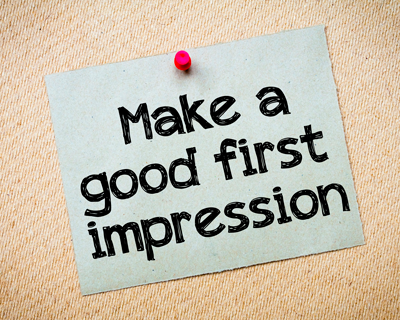Last updated on October 17th, 2025 at 01:31 pm
 What is the first impression that new patients (or potential new patients) get from your office? Good? Bad? Indifferent?
What is the first impression that new patients (or potential new patients) get from your office? Good? Bad? Indifferent?
The answer to this question can have a major effect on:
1. Whether or not they actually make it into the office for their appointment
2. If they come back to the office for treatment and/or hygiene, and
3. Refer their friends and family.
 Many offices go wrong on this point. And not because they don’t care. Many do. If anything, they’re focusing on the wrong place when attempting to create a positive first impression. And it goes without saying that everyone at every point of patient interaction should be friendly and welcoming. After all it’s just as easy to turn a “good” first impression into a terrible second, third or subsequent impression. But if you’re attempting create a positive first impression when you’re chairside, or even when a patient first walks in the office – you may be too late!
Many offices go wrong on this point. And not because they don’t care. Many do. If anything, they’re focusing on the wrong place when attempting to create a positive first impression. And it goes without saying that everyone at every point of patient interaction should be friendly and welcoming. After all it’s just as easy to turn a “good” first impression into a terrible second, third or subsequent impression. But if you’re attempting create a positive first impression when you’re chairside, or even when a patient first walks in the office – you may be too late!
The average patient forms their first impression of your office long before they see the doctor. Depending on which source you cite – a first impression is created within anywhere from less than 10 to as many as 30 seconds!
 So, when are they forming this impression? Well the first 10 to 30 seconds of interaction with your practice HAPPENS WHEN THEY FIRST CALL IN! In others words, before the patient walks in the door.
So, when are they forming this impression? Well the first 10 to 30 seconds of interaction with your practice HAPPENS WHEN THEY FIRST CALL IN! In others words, before the patient walks in the door.
I find that most dental offices don’t put nearly enough attention on this. And pay for it in lost potential new patients! On the flip side, proper phone management pays HUGE dividends in the long run.
Recent statistics in the area of patient conversion are pitifully low in terms of the percentage of new patient calls that actually schedule (and arrive) for an appointment. In an exhaustive study by Viva Dental, they found that the average dental office only converts approximately 23% of incoming new patient phone calls into appointments. That means 77% are completely wasted opportunities! Let that sink in for a minute.
And don’t get the idea that because the average office only convert 23%, then it’s “okay” for you office to do 40% or 50%. It’s not. We have clients converting more like 85-90%. That’s a good range to be in.
I’ve also met a ton of doctors who think, “I hear my front desk on the phone. They’re pretty good. I think they schedule just about every caller.” But then when we instruct them to track the number of calls and whether or not each one was scheduled for an appointment…well, let’s just say the results are enlightening.
The problem: you’re in the back. You’re working on patients. You probably don’t really know what’s actually going on right now with phone calls that are coming into your office and how they’re handled. It’s time to start being more proactive about it.
Why are so many of these new patient “opportunities” being wasted?
Many different factors can introduce into this. And truthfully, being “rude” or “mean” is usually NOT the problem. Bigger culprits are poor communication skills, making people wait and the inability to answer questions. And of course, we get the unfriendly, unwelcoming and indifferent attitude from time to time. But look, if I’m a new patient calling your office, and I’m placed on hold for two minutes, I’m probably going to hang up and go somewhere else! They weren’t rude, or mean. They just made me wait. First impression = FAIL.
 Different issue but same result, I call your office and your receptionist is momentarily flustered or annoyed; it comes through in their communication. They could be annoyed about the phone ringing too much, a problem with co-worker – who knows? I don’t, so I’ll probably assume it’s me! Well, if my first interaction is starting out like this, chances are it’s not going to get any better! I think I’ll be calling someone else.
Different issue but same result, I call your office and your receptionist is momentarily flustered or annoyed; it comes through in their communication. They could be annoyed about the phone ringing too much, a problem with co-worker – who knows? I don’t, so I’ll probably assume it’s me! Well, if my first interaction is starting out like this, chances are it’s not going to get any better! I think I’ll be calling someone else.
I could go on, but I’m sure you could think of any number of examples. The end result though is the same: prospective new patient that calls your competition. They’ll be a new patient for someone – just not you! And these are negative first impressions are being made on people who haven’t actually been to your office! And this doesn’t just hurt your conversion percentage; it’s also not doing any favors for you’re your office’s word-of-mouth. Think about it:
My friend Joe: “Hey I’m thinking of calling Dr. ________’s office for a cleaning. What do you know about them?”
Me: “I tried to make an appointment, ended up on hold for five minutes and hung up. I ended up calling Dr. (OTHER DENTIST) and he/she is great! Here’s their number.”
The upshot: you need to study – intently – what happens when calls come into your office. You need ensure that a) your staff answering the phone are doing it “right” and b) train (or replace if needed) them if they’re not! The costs of letting this go or being inactive can be staggering.
That said, what are a few of the “keys” to a positive first impression?
The Keys to a Good First Impression
1. Make it ALL about the patient.
If I call an office and I say “Hey I’d like to come in for an appointment” and the first thing I get is “Well what insurance do you have? What type of PPO is it?” It becomes not about me but about my insurance. It doesn’t seem like they care whether or not I’m in pain, whether or not I need help, whether or not I’m new to the area…these things are just pushed aside for some insurance facts.
That creates a negative first impression. Sure you might need this other info – but gosh…shouldn’t you establish at least SOME rapport with me first?
We teach exactly how to answer phones effectively at the MGE New Patient Workshop. Learn more here.
2. Make sure you have a receptionist that actually wants the phone to ring.
If you have a person who’s annoyed by the phone ringing and would prefer calls to go to voicemail (they are “busy,” you see), you can also bet that they would rather not talk to patients – or prospective patients. This attitude will shine through when they do interact on the phone. And you’ll see it in your new patient numbers.
 Ideally, the receptionist should get excited when the phone rings. Yay! It’s a new patient! We love having new people in the practice.
Ideally, the receptionist should get excited when the phone rings. Yay! It’s a new patient! We love having new people in the practice.
That’s the right attitude.
The fix? Well, maybe they are overloaded – lighten the load and get more help. Or maybe they don’t want to do the job and dislike handling the phones. Well, you may have to replace them at that point. Up to you.
3. When the patient does arrive in the office, greet them with a smile!
When a patient arrives, make sure that someone is there to greet them with a smile on their face, “Hello ____! How are you doing today?”
You don’t want a receptionist who’s rushed, doing five different things at once, just glancing up for a second to say “Oh you’re the new patient…here…fill out these papers. We’ll get with you in ten minutes.”
That also creates an impression in the patients’ mind of “I’m not important.”
So make sure that whoever answers the phone or greets patients wants to see them and is ready to take care of them. You may need to do more training, possibly adjust workload– and if all else fails and performance doesn’t improve, you may have to replace.
4. Make patients feel important and liked.
 Beyond excellent clinical care, making people feel like and wanted (should be genuine) is a part of customer service and a key retention strategy. People will be more apt to come back when you like them and you like communicating with them.
Beyond excellent clinical care, making people feel like and wanted (should be genuine) is a part of customer service and a key retention strategy. People will be more apt to come back when you like them and you like communicating with them.
They will be inclined to go somewhere else if they feel that they are bothersome or annoying by calling or troublesome for being there.
One of the quickest ways to make someone feel unimportant is to make them wait. It immediately says “our time is more important than yours.” It certainly doesn’t give the person a big motivation to come back or refer their friends to you. This article by MGE Client Dr. Ken Cirka provides some tips for running on-time: The 10-Minute Rule…Don’t Make Your Patients Wait!
And of course, if you really want to take control of your schedule, attend our free seminar The Art of Scheduling Productively Seminar when we come to a town near you.
Summary
Creating a good first impression is important—especially when it comes to answering the phone, because that might be the only impression you ever get a chance to make! And it’s also important to back this first impression up with the second, third, fifth and twenty seventh impression – they should all be consistently excellent.
If anything, I hope this information helps you create a uniformly excellent first impression with prospective patients!
A lot of this information, including the “how-tos” is covered at the MGE New Patient Workshop; and if you really want to get more new patients and improve retention, I highly suggest it! We cover every facet of new patient acquisition, from marketing that makes the phone ring to scheduling new patients and keeping them in the practice long-term. I can give you more information if you contact me.
Call (800) 640-1140 and ask for Neil if you ever need help with anything or have any questions. You can also email me at NeilW@mgeonline.com.



No Comments
Be the first to start a conversation